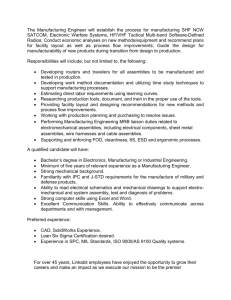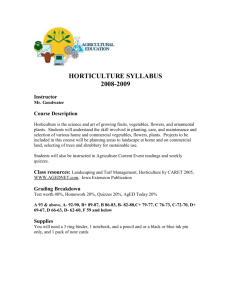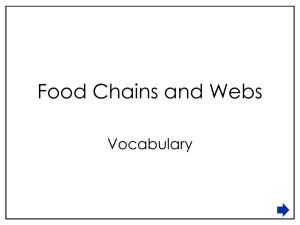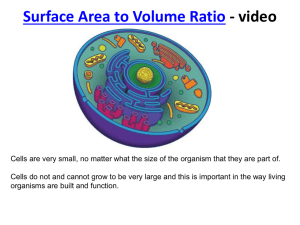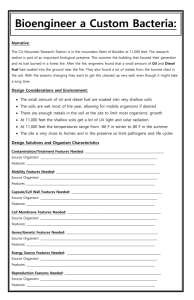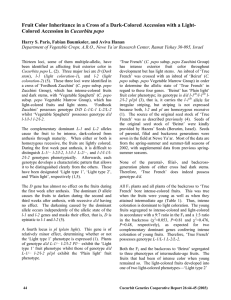Chap. 3 L-1 -cells- parts of an organism -cell theory
advertisement
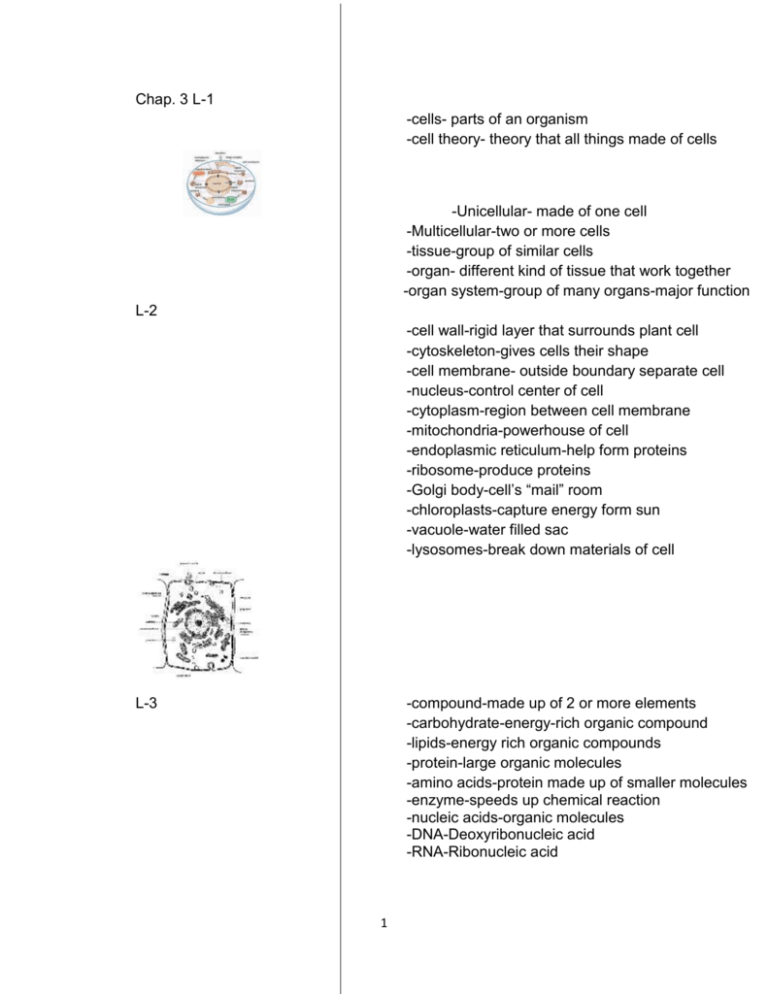
Chap. 3 L-1 -cells- parts of an organism -cell theory- theory that all things made of cells -Unicellular- made of one cell -Multicellular-two or more cells -tissue-group of similar cells -organ- different kind of tissue that work together -organ system-group of many organs-major function L-2 -cell wall-rigid layer that surrounds plant cell -cytoskeleton-gives cells their shape -cell membrane- outside boundary separate cell -nucleus-control center of cell -cytoplasm-region between cell membrane -mitochondria-powerhouse of cell -endoplasmic reticulum-help form proteins -ribosome-produce proteins -Golgi body-cell’s “mail” room -chloroplasts-capture energy form sun -vacuole-water filled sac -lysosomes-break down materials of cell L-3 -compound-made up of 2 or more elements -carbohydrate-energy-rich organic compound -lipids-energy rich organic compounds -protein-large organic molecules -amino acids-protein made up of smaller molecules -enzyme-speeds up chemical reaction -nucleic acids-organic molecules -DNA-Deoxyribonucleic acid -RNA-Ribonucleic acid 1 L-4 -selectively permeable-some substances can pass -diffusion-higher to lower concentration -osmosis-diffusion of water molecules -passive transport-movement of dissolved mater. -active transport-movement use cellular energy Chap. 4 L-1 -photosynthesis-plants make their own food -autotroph-thing that can make own food -heterotroph-thing that can’t make own food -pigment-colored chemical compounds -chlorophyll-photosynthetic pigment -stomata-small opening on underside of plant L-2 -respiration-cells obtain energy from glucose -fermentation-energy releasing protein L-3 -cell cycle-cycle or growth and division in cells -interphase-period before cell division -replication-and exact copy -mitosis-stage nucleus divides into two nuclei -chromosomes-double rod structure -cytokinesis-final stage in cell cycle 2 L-4 -differentiation-cells change structure -stem cells-these differentiate through life Chap. 5 L-1 -heredity-passing of physical traits -trait-different form of characteristic -genetics-scientific study of heredity -fertilization-egg and sperm join -purebred-offspring that has same trait -gene-factor that control trait -alleles-different form of gene -dominant allele-trait always shows up -recessive allele-hidden, dominant present -hybrid-organism 2 different alleles L-2 -probability-predict results of event -Punnett square-chart that show outcome -phenotype-physical appearance -genotype-genetic makeup -homozygous-same alleles -heterozygous-different alleles -codominance-inheritance pattern L-3 -sexual repro.-creates new organism -diploid-two sets of chromosomes -meiosis-chromosomes reduced to half 3 L-4 Chap.6 L-1 -Messenger RNA-copies coded message -transfer RNA-carries amino acids -mutation-change in gene or chromosome -multiple alleles-three or more forms a gene -sex chromosomes-23 pairs in each cell -sex-linked genes-X, Y chromosome -carrier-one recessive, dominant allele L-2 -genetic disorder-abnormal condition -pedigree-chart of family tree -karyotype-picture of all chromosomes L-3 -selective breeding-selecting organism -inbreeding-cross two that are same -hybridization-cross two that are different -clone-same exact replica -genetic engineering- transferred from one to other -gene therapy-correct human disorders -genome-all DNA-one organism 4 Chap. 16 L-1 -Endocrine glands-produce,release chemical products -hormone-signal activities of body -target cells-recognize hormone structure -hypothalamus-tiny part of brain -pituitary gland-communicate hypothalamus -negative feedback-type of signal L-2 -egg-female sex cell -sperm-male sex cell -testes-sperm are produced -scrotum-external pouch of skin -testosterone-hormone control physical -semen-mixture of sperm cells,fluids -penis-male repro. System -urethra-a tube through penis -ovaries-female repro. System -estrogen-hormone of female body -fallopian tubes-passageway for egg -uterus-hollow muscular organ -vagina-leads to outside body -menstrual cycle-monthly cycle stages -follicle-grouping of cells -ovulation-an egg is released -menstruation-extra blood tissue, removed L-3 -embryo-8th week developed human -fetus-9th week developed human -amniotic sac-fluid-filled sac -placenta-develops fetal tissue -umbilical cord-ropelike structure -adolescence-children mature into adults -puberty-period to be able to reproduce 5 Endocrine System Reproductive System -produces chemicals that control many of the bodies daily activities as well as growth/development -negative feedback; when a particular hormone gets to a specific level the ES stops the release of that hormone -> eggs -> sperm Chap. 7 L-1 -species-a group of similar organisms -fossil-preserved remains,traces of organism -adaptation-trait that helps organisms survive -evolution-change over time in species -scientific theory-well tested concept that explains many theories -natural selection-individuals better adapted to their environment -variation-difference between same species L-2 -comparative anatomy-comparison of different structures -homologous-same structure -mold-hollow area in sediment in shape -cast-solid copy of shape organism -petrified fossils-minerals replace organism -trace fossils-evidence of activites-organism -Paleontologists-scientists who study fossils -gradualism-hypothesis -punctuated equilibria-accounts gaps-fossil L-3 -habitat-organism’s home, environment -extinct-no more species alive 6
